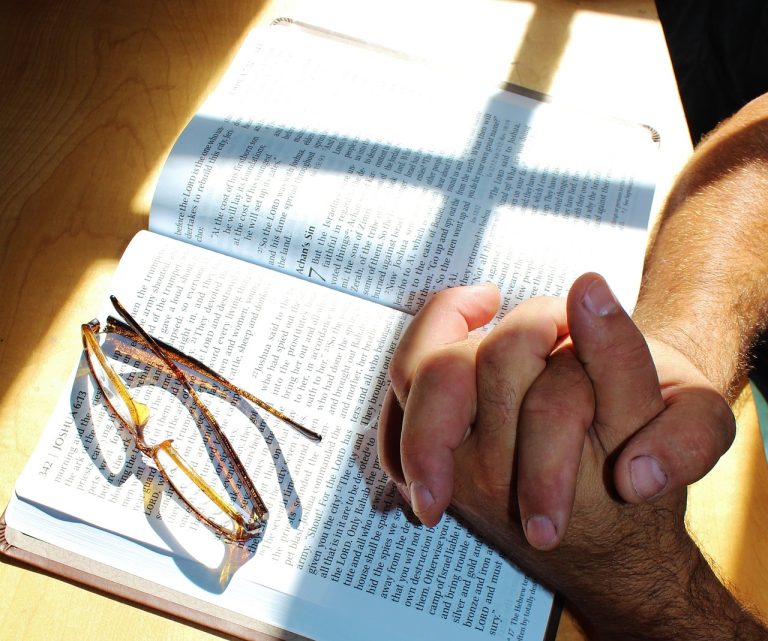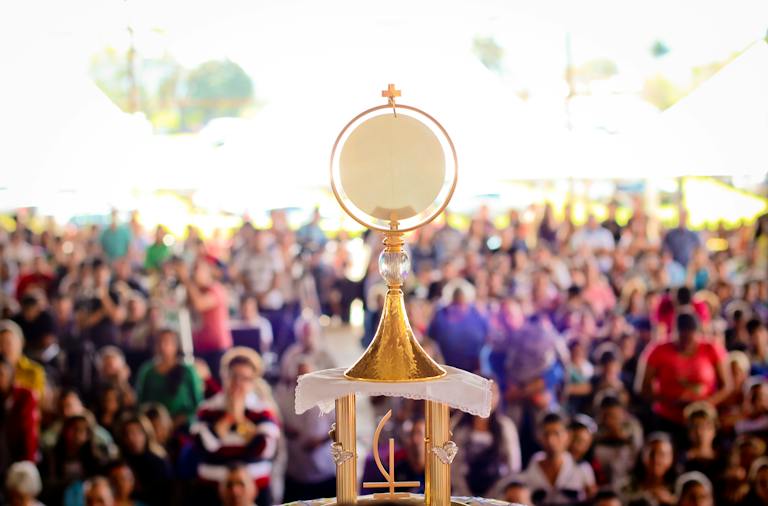Practice the Daily Examen and Find God in Every Moment
St. Ignatius of Loyola took seriously Jesus’ admonition to “keep awake” for the coming of the Lord in every moment. You can, too, by practicing his Daily Examen.
The following article is abridged from the introduction to The Daily Examen Journal: A 30-Day Spiritual Retreat.
St. Ignatius of Loyola (1491–1556), the Spanish soldier turned spiritual warrior, took seriously Jesus’ admonition to “keep awake” for the coming of the Lord (Matthew 24:42)—not just at the end of time, but in every moment of every day. And by his own measure, by the end of his life, he had largely succeeded in this task: “Whenever he wished, at whatever hour, he could find God,” he said of himself in his Autobiography.
This spiritual richness, this sensitivity to God’s presence, didn’t just happen. Instead, it was the fruit of his daily practice of prayerfully reflecting on God’s movement within the deepest part of his heart. Fortunately for the rest of us, St. Ignatius taught this practice to the members of the religious order he founded, the Society of Jesus (“the Jesuits”). The practice he developed has come to be known as the Ignatian Examen (also known as the Daily Examen, or the Examen/examination of consciousness).
What Is the Examen?
As its Latin name suggests, the examen prayer is a spiritual self-examination, the purpose of which is to become more conscious of the movement of God in the everyday events of our lives. We examine our own feelings, thoughts, words, and actions in each part of the day, asking: “Where was God in this moment? Where was I?” We not only ask, “How did I live today?” but also, “What moved me to live the way I did? Was I moved by God or by something else?”
Over time, this practice of “waking up” to God also awakens us to our true self … the fullness of the person God calls us to be.
The ultimate purpose of this prayerful, Spirit-guided examination is to become more and more sensitive to God’s presence and promptings within us, not only while we are praying the Examen, but all the time.
The ultimate purpose of this prayerful, Spirit-guided examination is to become more and more sensitive to God’s presence and promptings within us, not only while we are praying the Examen, but all the time. And as we get better at recognizing God’s presence throughout our days, it becomes easier to more lovingly respond to his many gifts in our thoughts, words, and actions.
When should you pray the Examen? Although Jesuits are required to pray the Examen twice a day, once at midday and once in the evening, most lay people pray it once a day. You can pray it at any time of day that is convenient; if you pray it at some time other than in the evening, simply review the period since you last did an examen (or the previous twenty-four hours). Most people allow about fifteen minutes to do the Examen well; in a pinch, it can be abbreviated.
The Six Movements of the Examen
Now let’s take a closer look at the six movements of the Examen prayer. As with any commentary on prayer, the description that follows shouldn’t be understood as a strict, one-size-fits-all recipe. Prayer is a conversation between God and an individual person, which means it is always unique. In fact, if you make the regular practice of the Examen a habit, its various movements will eventually flow more naturally under the prompting of the Holy Spirit.
1. Pray for Enlightenment
We begin the Examen by praying for the guiding light of the Holy Spirit. As Christians, we believe that the Holy Spirit “inspired” (or breathed life into) the sacred Tradition and Scriptures of the Church. But we also believe that this life-giving work of the Spirit continues in the Church—in each of us—today.
The first movement of the Examen, therefore, is to invite the Holy Spirit to enlighten your heart—to teach you, to breathe life into you—during this time of prayer.
Could you benefit from reflecting on your day on your own, without the help of the Holy Spirit? Surely many people do. But without the help of the Holy Spirit, our own pride, ignorance, or laziness may prevent us from seeing the truth about ourselves. If we are open to the help of the Holy Spirit, he will gradually, gently reveal our true selves to us. We should welcome this healing, nurturing light of the Holy Spirit because God desires nothing for us other than our ultimate happiness.
How do you invite the Holy Spirit to accompany you during this time of prayer? You might simply pray: “Holy Spirit, open my heart; enlighten me with your love, so that I might grow closer to you.” You can, of course, use your own words to express this simple sentiment.
Besides praying these words, you might also spend a few moments settling down, quieting your mind to make room for the Spirit. Relax, restfully leaning into God’s presence. Think of giving yourself over to God as a physical sensation similar to relaxing into a back float in the pool, or a kiss.
2. Give Thanks
Gratitude is the foundation of our relationship with God. In the second step, then, we thank God for the many gifts, both large and small, that we have received throughout the day.
Practicing gratitude puts us in right relationship with God. It acknowledges two fundamental truths:
- We are nothing and have nothing in ourselves, nor are we “owed” anything.
- God is everything, has blessed us with everything we have, and wishes to give us even more—all of himself.
Taking time every day to appreciate these truths helps us avoid the sins of ingratitude (taking God’s gifts for granted) and resentment (sulking over not getting what we think we deserve).
The daily practice of gratitude leads us to experience a deep spiritual joy in the realization that everything is a gift.
The daily practice of gratitude gradually leads us to experience a deep spiritual joy in the realization that everything is a gift. And our natural response to this gift of “everything” is to praise and thank God.

The Daily Examen Journal:
A 30-Day Spiritual Retreat
Where does that leave the rest of us? Some of us have bad days, bad weeks, or even a lifetime filled with more than our fair share of trouble and sorrow. Many of us also experience depression. We can hardly be expected to start out like St. Francis. But being attentive to God’s gifts in our lives and giving him thanks is even more important in these circumstances. Going through the motions of naming God’s gifts in our lives might be the best we can do, but it’s a start, and we can do this while also praying for the Holy Spirit to help us feel real gratitude. We do so not for God’s sake, but for our own sake—so that, even in the darkness, we might know the light of God’s love.
3. Examine Your Thoughts, Words, and Actions
In the third movement, we examine our thoughts, words, and actions over the course of the day (or since the last time you did the Examen). Reviewing the day hour by hour, we remember how we acted toward God, others, and ourselves. We might ask:
- How have I treated myself today?
- How have I treated others in my thoughts, words, and actions?
- How have I connected (or not connected) with God today?
We’re not so much counting up our moral victories and defeats as we are simply taking a clear-eyed look at our story as it unfolded today. We’re practicing awareness, consciousness … keeping our eyes open. This is the first step toward intentionality, the practice of consciously directing our actions. With consciousness comes freedom, and with freedom comes the ability to act according to God’s love for us. This is the goal of the Examen.
Although what we say and do may be at the top of our mind during our review of the day, St. Ignatius is most concerned with our thoughts, attitudes, and feelings, because it is these that give rise to our words and actions. He takes his cue from Jesus: “The good person out of the good treasure of the heart produces good, and the evil person out of evil treasure produces evil; for it is out of the abundance of the heart that the mouth speak.” (Luke 6:45)
As we review our day, then, we may at first focus on our words and actions. Prompted by the Holy Spirit, one or more of these may particularly grab our attention—perhaps a conflict we had with someone, our sour mood, or the way we responded to something bad happening to us. Or the Holy Spirit may direct our attention to a “high” moment—the joy we felt joking around with coworkers, some small kindness we did for a stranger, or a difficult moment handled with grace.
With the help of the Holy Spirit, we are seeking to know the truth about ourselves so that we might grow into our true self, the fullness of the person God made us to be.
Our next move should be to ask: What was the driving force behind what I did or said? What thoughts or habits of the heart prompted me to act the way I did? With the help of the Holy Spirit, we are seeking to know the truth about ourselves so that we might grow into our true self, the fullness of the person God made us to be.
4. Respond in Prayer
After our clear-eyed, honest examination in the previous step, it is natural for us to respond in prayer to whatever the Holy Spirit has revealed to us.
Maybe our day has been full of spiritual “highs,” moments when we’ve felt especially connected to God, and our actions have been truly free. If so, take a moment to celebrate and rejoice, praising and thanking God for his grace at work in your life.
On the other hand, our review of the day might reveal moments of sinfulness … or, at the very least, moments when we have fallen short, failing to respond to God’s call as fully as we should. These moments might cause us sorrow, but this sorrow ought to be tempered by gladness that the Holy Spirit is helping us to grow closer to God. We can respond in prayer by expressing our sorrow to God and asking his forgiveness.
A sense of guilt and sorrow is good as long as it leads us to seek God’s help and healing. Shame or despair, on the other hand, drives us away from him and should be avoided. If you find that shame is causing problems in your spiritual life, seek the help of a pastor or spiritual director.
5. Resolve to Live More Fully in Christ Tomorrow
Next, we resolve to live more fully in Christ in the coming day. Our resolution(s) ought to be simple, specific, and grounded in the insights we gained from our review of the previous day. For example, if we fell short in the way we treated a spouse or coworker, we might resolve—in very specific terms—to do better the next day. Alternatively, we might imagine a creative way to build on our spiritual successes; if we’re celebrating our heroic patience with the children today, we might resolve that tomorrow we will strive to go further by really appreciating them, perhaps even offering them a compliment.
6. Conclude in Prayer
St. Ignatius reminds us that our resolutions to do better are always accomplished “with the help of God’s grace.” We can close our time of prayer by very deliberately asking the Holy Spirit to open our hearts to his grace in the coming day.
St. Ignatius suggests we conclude with the Our Father, but you could conclude with another favorite prayer, or just the sign of the cross.
In Closing
Prayer is the work of the Holy Spirit; it is dynamic, not static. The same is true of the Daily Examen. Over the centuries, various people have built on the foundation offered by St. Ignatius, proposing different ways to pray the Examen—emphasizing one aspect or another, or explaining its movements in new ways. If the Examen becomes a regular practice, you might benefit from reading about other approaches.
An excellent place to begin is IgnatianSpirituality.com, a website maintained by Loyola Press. The “Daily Examen” page at that website contains links to numerous helpful articles, videos, and apps. Two articles especially worth reading are “Consciousness Examen,” a classic work by Fr. George Aschenbrenner, SJ (also available as a booklet called Examination of Consciousness from Loyola Press), and “A Method of Making the General Examen” from the Manresa Jesuit Spiritual Renewal Centre.
For a more in-depth description, see The Examen Prayer: Ignatian Wisdom for Our Lives Today by Fr. Timothy M. Gallagher, OMV (Crossroad, 2006, 192 pages).
In closing, let’s pray the Suscipe, a beautiful prayer of abandonment proposed by St. Ignatius:para
Receive, O Lord, all my liberty. Take my memory,
understanding, and entire will. Whatever I have or possess you have given me; I restore it all to you, and surrender it wholly to be governed by your will.
Give me love for you alone along with your grace,
and I am rich enough, and ask for nothing more.
Get a free three-entry sample of The Daily Examen Journal.









Thank you!